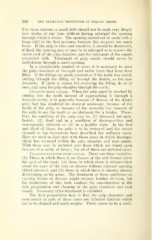Page 734 - My FlipBook
P. 734
380 THE TECHNICAL PROCEDURES IN FILLING TEETH. ;
For these reasons, a small drill should not be sunk very deeply
into dentin at any time without having enlarged the opening
through wliich it works. The opening should not be made with a
large drill in the first instance, because this requires too much
force. If the pulp is alive and sensitive, it should be destroyed
if dead, the opening may at once be so enlarged as to remove the
entire roof of the pulp chamber, and the treatment of the canals
proceeded with. Treatment of pulp canals should never be
undertaken through a small opening.
In a considerable number of cases it is necessary to open
the pulp chambers of bicuspid and molar teeth that have been
filled. If the fillings are good, proceed as if the tooth was sound,
cutting through the filling, or through the dentin, as the case
demands. If there is reason for removing the filling, do so at
once, and open the pulp chamber through the cavity.
Cleaning root canals. When the pulp must be reached by
cutting into the tooth instead of approaching it through a
decayed cavity, it is generally because of disease of the dental
pulp that has rendered its removal necessary, because of the
death of the pulp, or because of the necessity for removal of
the pulp to use the tooth as an abutment for a bridge. There-
fore, the condition of the pulp may be, (1) diseased, but unin-
fected; (2) dead and in a condition of decomposition and
consequently infected, or (3) in a healthy state. In the first
and third of these, the pulp is to be removed and the canals
cleaned as has heretofore been described for ordinary cases.
Here we need to deal only with those cases in which decompo-
sition has occurred within the pulp chamber and root canals.
With these may be included also those which are found open
because of a cavity of decay ; for all of these are infected eases.
Cleaning infected pulp canals. There are three varieties.
(1) Those in wliich there is no disease of the soft tissues about
the apex of the root; (2) those in which there is inflammation
about the apex of the root or abscess without external opening
(blind abscess), and (3) those in which there is chronic abscess
discharging on the gums. The treatment of these conditions as
varying forms of disease might require further division, but
the limitations of this book confines the consideration to the
safe preparation and cleaning of the pulp chambers and root
canals. Necessary after-treatment is excluded.
The first proposition here is that the pulp chambers and
root canals in each of these cases are infected districts which
are to be cleaned and made aseptic. There seems to be a senti-


